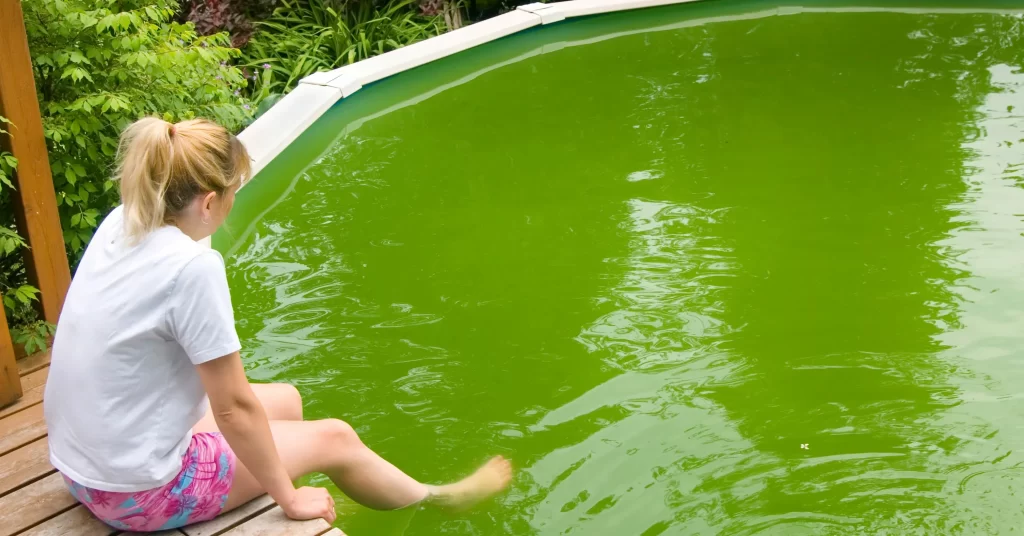
Any home would be enhanced by the inclusion of a pool. They are excellent for physical treatment as well as exercise and leisure purposes. Looking into the pool and seeing green water is one way to prevent that cool dip from happening. Find out more about green pool water and whether it’s safe to swim in a green pool or not by reading on.
Algae is usually the cause when pool water changes from a clear blue color to any shade of green. Mustard and green algae are the two types of algae that are most commonly found. Let’s examine the variations.
Green algae: A chemical imbalance is most likely what caused this algae to emerge.
Dead algae known as mustard algae are generally the result of inadequate filtration or circulation.
The following information is true:
It can be beneficial to swim in substances like chlorine and bromine to prevent the formation of these algae.
Green water resulting from algal oxidation can discolor swimming pools and cause hair to become green.
Depending on where you live, airborne pollen may be too small to filter out of the pool, which leads to its accumulation. Your water may be turning green if you reside in an area where pollen levels are so high that your cars are covered in yellow dust.
Bacteria and parasites are drawn to algae. These microorganisms can enter the body through a small wound, the mouth, nose, eyes, or ears. Swimming in green pool water is less safe in this scenario. This explains the significance of routine chemical testing.
If the green hue is caused by pollen, there might not be much that can be done to minimize the discoloration other than creating a structure around the pool. Luckily, green pool water is acceptable to swim in, provided that allergies to pollen are not present.
Before swimming in any green pool water, please see a specialist if you are unsure whether your pool has algae.
If prevention is no longer an option, more action is required than simply adding a small amount of chlorine to the pool. It’s time to thoroughly clean.
Initially, you must vacuum the pool to get rid of the algae and other debris. Make sure the vacuum filter is set to Waste because it is not desirable for the “junk” to re-enter the pool.
For this exact scenario, specific algae brushes are available. Algae is tough, so to make sure it gets everywhere, it’s better to use a firmer brush rather than one with softer bristles.
It’s crucial to obtain the present starting point in order to determine how to modify the compounds. If it is more convenient for you, you can do this as the initial step.
The algae is killed by this method. A cleaner with concentrated chlorine, ideally one with a level higher than 70%, is called pool shock. Even if your usual shock doesn’t contain chlorine, you still need to use it for this.
You could question, but what microorganisms could be in the water that could harm me?
That child across the street, though, who a few days earlier experienced diarrhea due to the “stomach flu”? For up to two weeks afterward, he can continue to disperse germs in the water. Additionally, you run the risk of contracting a severe gastrointestinal ailment if you inhale the aerosolized spray while playing or if you accidentally breathe in some of that water through your mouth or nose. Swimming should be avoided for two weeks following any diarrheal sickness, according to the CDC. You can still spread germs for some time after the symptoms have subsided. The more frequent “bugs” that pose a threat are Giardia, Cryptosporidium, Norovirus, E. Coli, and Shigella.
Irritation of the eyes or lungs is another issue that some hot tubs and pools may have. Legionnaires’ illness can be contracted by breathing in the mist of tainted water containing Legionella bacteria.
Have you ever noticed a strong “bleachy” fragrance when you visit a pool? Although you claim to smell “chlorine,” a healthy pool doesn’t smell like chlorine. In actuality, you are smelling combined chloramines, which are the result of any chlorine in the pool being overpowered by perspiration, urine, and bacteria in the water. Alright, so gross? Actually, more chlorine is needed to get rid of the cooties in the water.
Read more about what should be the standard size of your swimming pool
The danger of drowning in a green pool is simply too large for a pool owner to consider taking a brief swim in one. In addition, the presence of different viruses or diseases that might spread from person to person because sanitizer is not used can make foggy pool water just as deadly. DON’T consider taking a fast plunge or caving in to your daughter’s demands and allowing her to throw the poolside birthday party as it is not safe to swim in a green pool! Rather, get some squirt guns and water balloons from the dollar shop.
Copyright © 2023 Watchtower Pools, LLC. All Rights Reserved.
